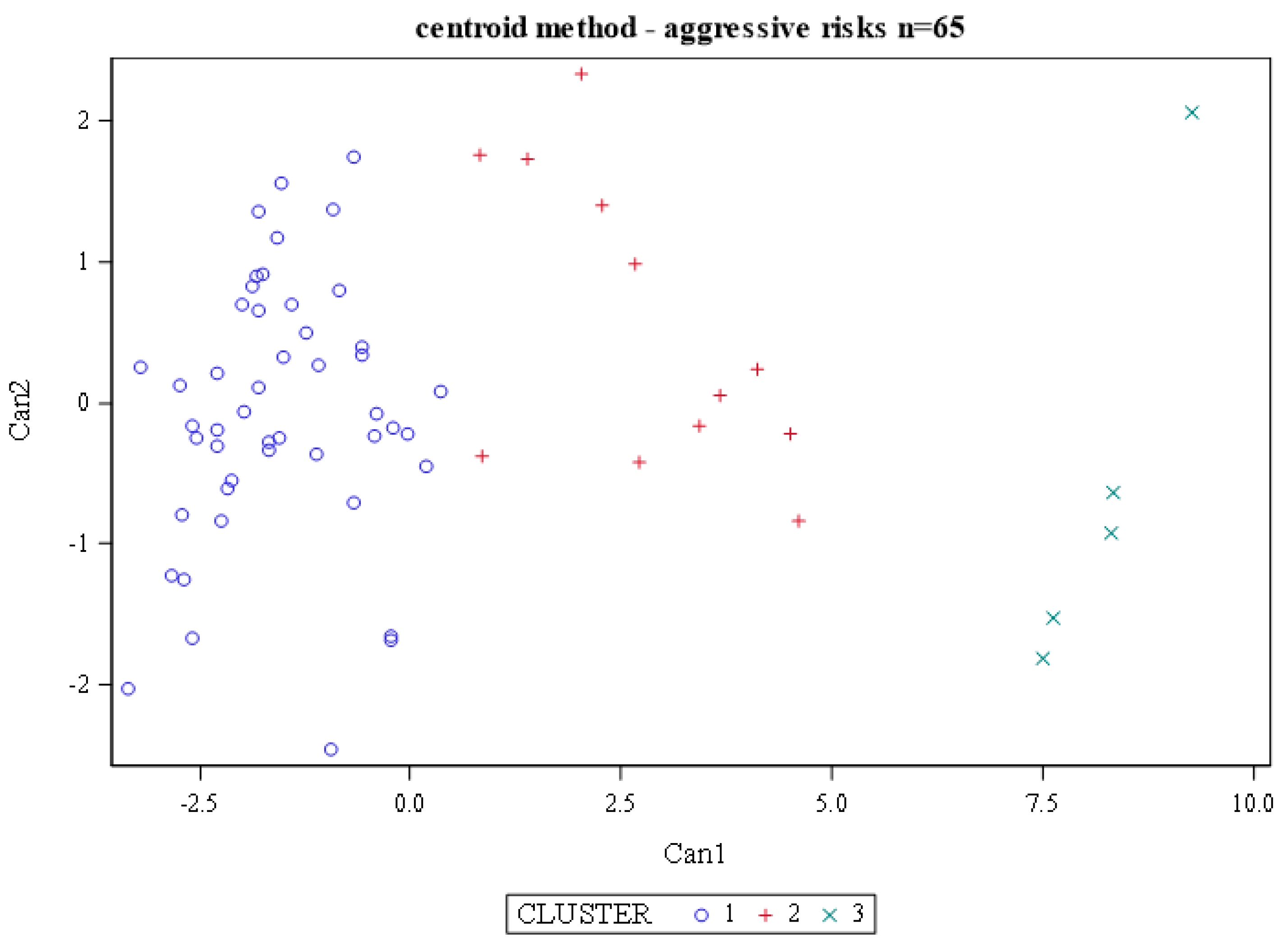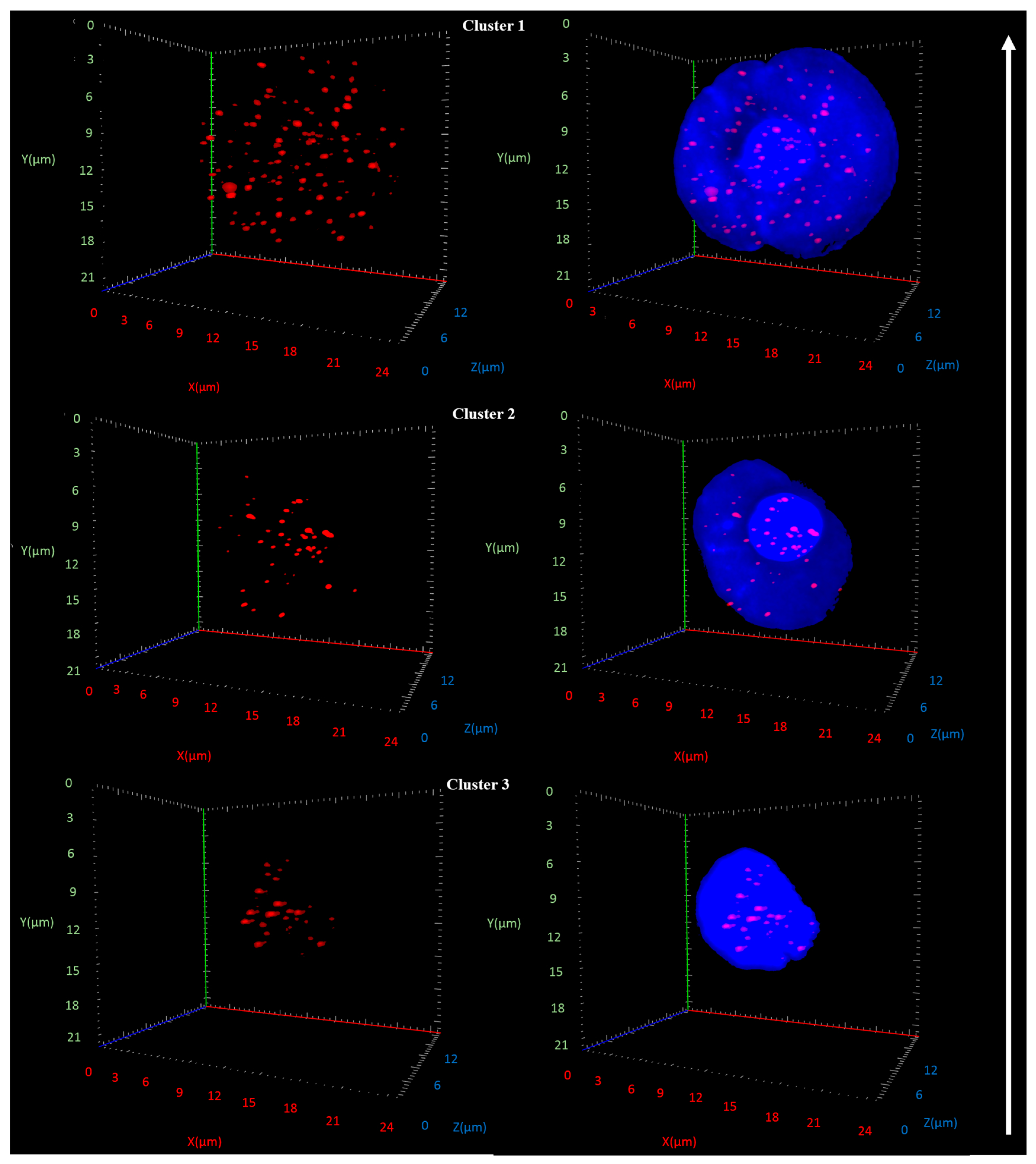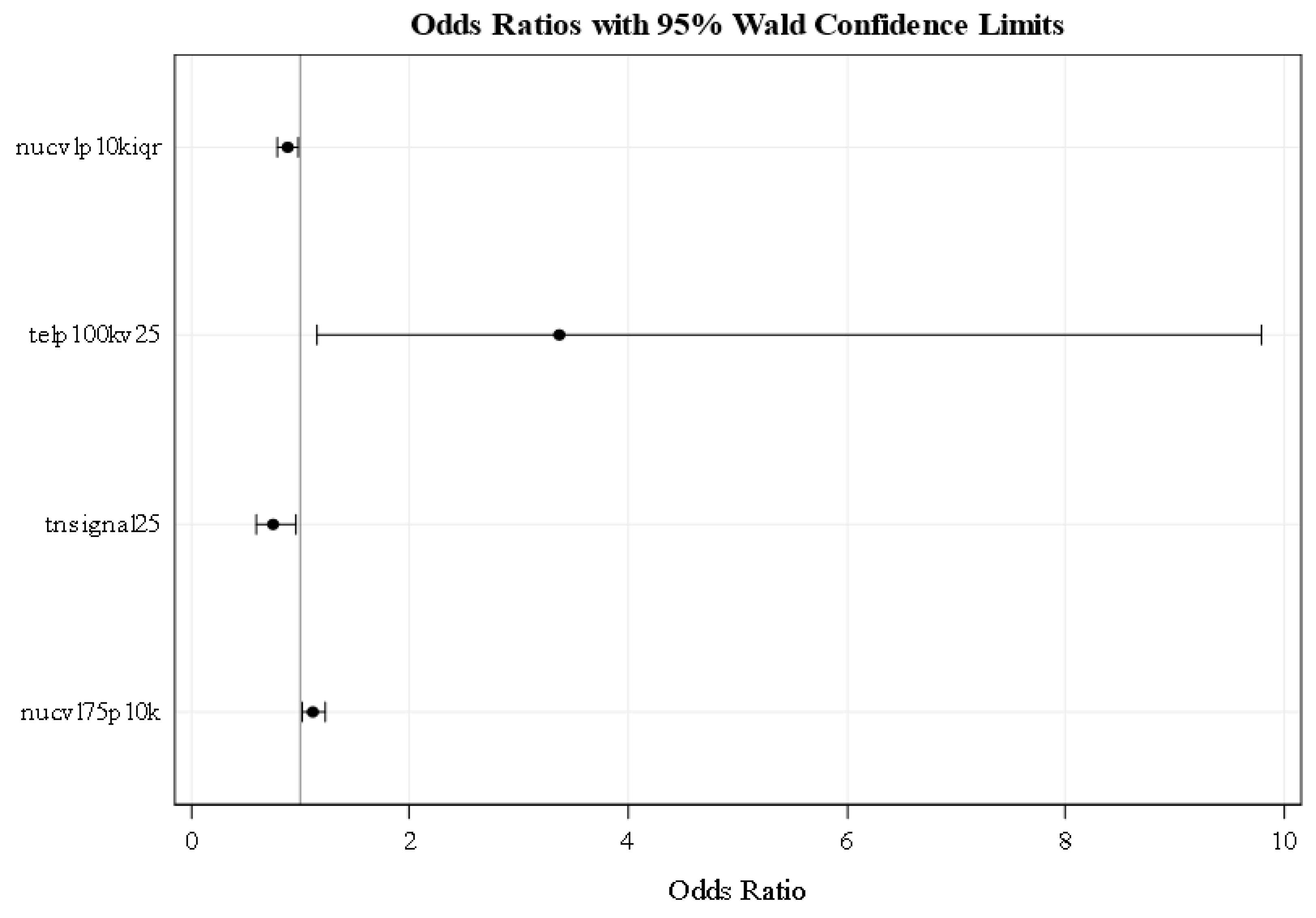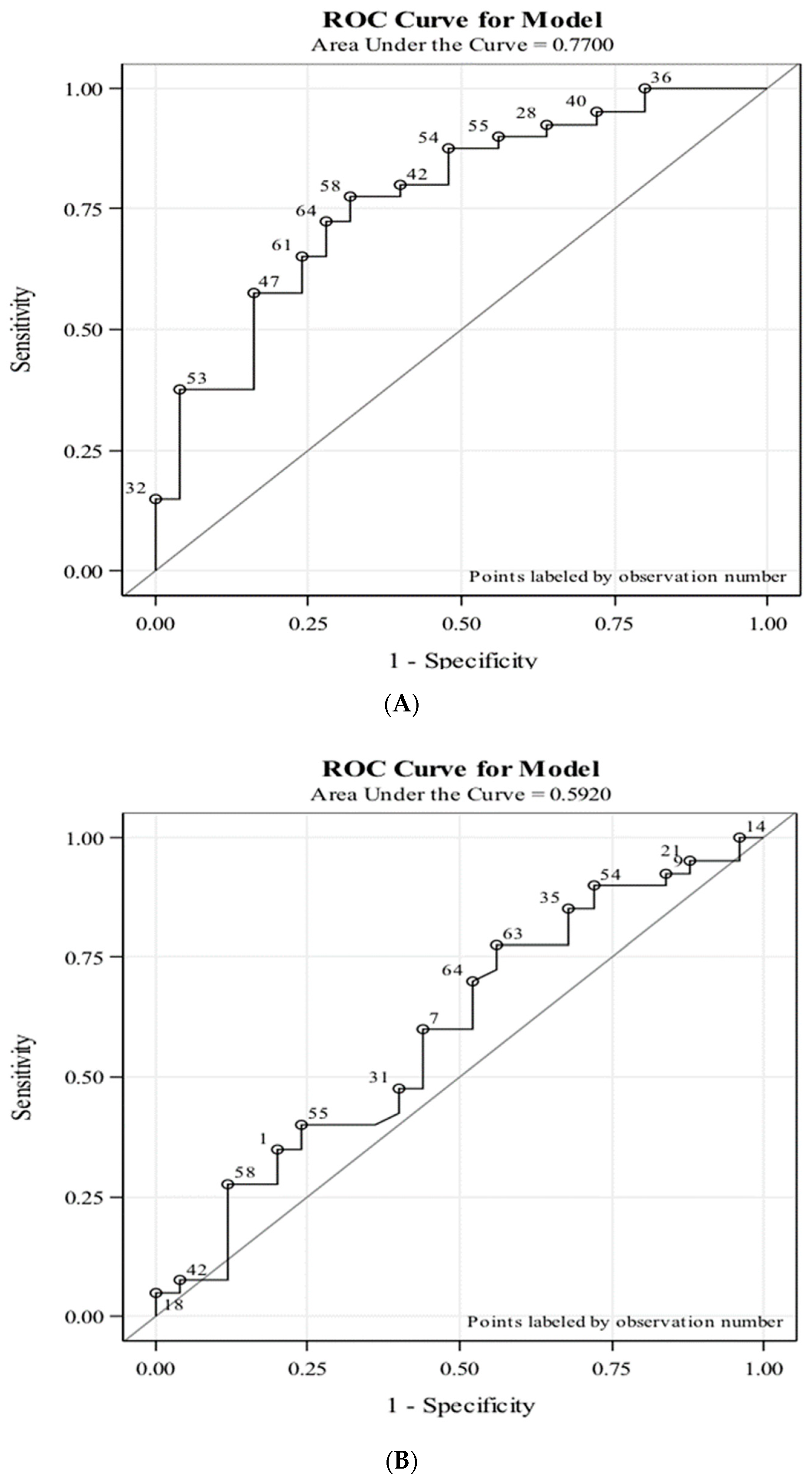Advancing Risk Assessment of Intermediate Risk Prostate Cancer Patients
Abstract
1. Introduction
2. Results
2.1. Pathology Reports after Radical Prostatectomy Show Close Association with Pre-Operative 3D Profiling Results of CTCs
2.2. Three-Dimensional (3D) Telomere Profiling of CTCs from Intermediate Risk Prostate Cancer Patients
2.3. Modeling of 3D Telomeric CTC Parameters
3. Discussion
4. Materials and Methods
4.1. Patients and Collection of Circulating Tumor Cells
4.2. Three-Dimensional Telomere Hybridization and Analysis
4.2.1. Quantitative Fluorescent in Situ Hybridization (QFISH)
4.2.2. Three-Dimensional (3D) Telomere Imaging and Analysis
4.3. Statistical Analyses
5. Conclusions
Supplementary Materials
Author Contributions
Funding
Acknowledgments
Conflicts of Interest
References
- Lalonde, E.; Ishkanian, A.S.; Sykes, J.; Fraser, M.; Ross-Adams, H.; Erho, N.; Dunning, M.J.; Halim, S.; Lamb, A.D.; Moon, N.C.; et al. Tumour genomic and microenvironmental heterogeneity for integrated prediction of 5-year biochemical recurrence of prostate cancer: A retrospective cohort study. Lancet Oncol. 2014, 15, 1521–1532. [Google Scholar] [CrossRef]
- Barbieri, C.E.; Demichelis, F.; Rubin, M.A. Molecular genetics of prostate cancer: emerging appreciation of genetic complexity. Histopathology 2012, 60, 187–198. [Google Scholar] [CrossRef] [PubMed]
- Beltran, H.; Yelensky, R.; Frampton, G.M.; Park, K.; Downing, S.R.; MacDonald, T.Y.; Jarosz, M.; Lipson, D.; Tagawa, S.T.; Nanus, D.M.; et al. Targeted next-generation sequencing of advanced prostate cancer identifies potential therapeutic targets and disease heterogeneity. Eur. Urol. 2013, 63, 920–926. [Google Scholar] [CrossRef] [PubMed]
- Schoenborn, J.R.; Nelson, P.; Fang, M. Genomic profiling defines subtypes of prostate cancer with the potential for therapeutic stratification. Clin. Cancer Res. 2013, 19, 4058–4066. [Google Scholar] [CrossRef] [PubMed]
- Boutros, P.C.; Fraser, M.; Harding, N.J.; de Borja, R.; Trudel, D.; Lalonde, E.; Meng, A.; Hennings-Yeomans, P.H.; McPherson, A.; Sabelnykova, V.Y.; et al. Spatial genomic heterogeneity within localized, multifocal prostate cancer. Nat. Genet. 2015, 47, 736–745. [Google Scholar] [CrossRef]
- Klotz, L. Contemporary approach to active surveillance for favorable risk prostate cancer. Asian J. Urol. 2019, 6, 146–152. [Google Scholar] [CrossRef]
- Kane, C.J.; Eggener, S.E.; Shindel, A.W.; Andriole, G.L. Variability in Outcomes for Patients with Intermediate-risk Prostate Cancer (Gleason Score 7, International Society of Urological Pathology Gleason Group 2–3) and Implications for Risk Stratification: A Systematic Review. Eur. Urol. Focus. 2017, 3, 487–497. [Google Scholar] [CrossRef]
- Klotz, L. Active surveillance for intermediate risk prostate cancer. Curr. Urol. Rep. 2017, 18, 80. [Google Scholar] [CrossRef][Green Version]
- Pollard, M.E.; Hobbs, A.R.; Kwon, Y.S.; Katsigeorgis, M.; Lavery, H.J.; Levinson, A.; Bernstein, A.N.; Collingwood, S.A.; Hall, S.J.; Samadi, D.B.; et al. Heterogeneity of Outcomes in D'Amico Intermediate-Risk Prostate Cancer Patients after Radical Prostatectomy: Influence of Primary and Secondary Gleason Score. Oncol. Res. Treat. 2017, 40, 508–514. [Google Scholar] [CrossRef]
- Pantel, K.; Hille, C.; Scher, H.I. Circulating Tumor Cells in Prostate Cancer: From Discovery to Clinical Utility. Clin. Chem. 2019, 65, 87–99. [Google Scholar] [CrossRef]
- Mai, S. Genomic instability and circulating tumor cells in prostate cancer. Transl. Cancer Res. 2018, 7, S192–S196. [Google Scholar] [CrossRef]
- Mader, S.; Pantel, K. Liquid Biopsy: Current Status and Future Perspectives. Oncol. Res. Treat. 2017, 40, 404–408. [Google Scholar] [CrossRef] [PubMed]
- Scher, H.I.; Lu, D.; Schreiber, N.A.; Louw, J.; Graf, R.P.; Vargas, H.A.; Johnson, A.; Jendrisak, A.; Bambury, R.; Danila, D.; et al. Association of AR-V7 on Circulating Tumor Cells as a Treatment-Specific Biomarker With Outcomes and Survival in Castration-Resistant Prostate Cancer. JAMA Oncol. 2016, 2, 1441–1449. [Google Scholar] [CrossRef] [PubMed]
- Heller, G.; McCormack, R.; Kheoh, T.; Molina, A.; Smith, M.R.; Dreicer, R.; Saad, F.; de Wit, R.; Aftab, D.T.; Hirmand, M.; et al. Circulating Tumor Cell Number as a Response Measure of Prolonged Survival for Metastatic Castration-Resistant Prostate Cancer: A Comparison With Prostate-Specific Antigen Across Five Randomized Phase III Clinical Trials. J. Clin. Oncol. 2018, 36, 572–580. [Google Scholar] [CrossRef]
- Lorente, D.; Olmos, D.; Mateo, J.; Dolling, D.; Bianchini, D.; Seed, G.; Flohr, P.; Crespo, M.; Figueiredo, I.; Miranda, S.; et al. Circulating tumour cell increase as a biomarker of disease progression in metastatic castration-resistant prostate cancer patients with low baseline CTC counts. Ann. Oncol. 2018, 29, 1554–1560. [Google Scholar] [CrossRef] [PubMed]
- Scher, H.I.; Graf, R.P.; Schreiber, N.A.; McLaughlin, B.; Lu, D.; Louw, J.; Danila, D.C.; Dugan, L.; Johnson, A.; Heller, G.; et al. Nuclear-specific AR-V7 Protein Localization is Necessary to Guide Treatment Selection in Metastatic Castration-resistant Prostate Cancer. Eur. Urol. 2017, 71, 874–882. [Google Scholar] [CrossRef] [PubMed]
- Vermolen, B.J.; Garini, Y.; Mai, S.; Mougey, V.; Fest, T.; Chuang, T.C.; Chuang, A.Y.; Wark, L.; Young, I.T. Characterizing the three-dimensional organization of telomeres. Cytometry A. 2005, 67, 144–150. [Google Scholar] [CrossRef]
- Mai, S.; Garini, Y. Oncogenic remodeling of the three-dimensional organization of the interphase nucleus: c-Myc induces telomeric aggregates whose formation precedes chromosomal rearrangements. Cell Cycle 2005, 4, 1327–1331. [Google Scholar] [CrossRef]
- Mai, S.; Garini, Y. The significance of telomeric aggregates in the interphase nuclei of tumor cells. J. Cell Biochem. 2006, 97, 904–915. [Google Scholar] [CrossRef]
- Gadji, M.; Vallente, R.; Klewes, L.; Righolt, C.; Wark, L.; Kongruttanachok, N.; Knecht, H.; Mai, S. Nuclear remodeling as a mechanism for genomic instability in cancer. Adv. Cancer Res. 2011, 112, 77–126. [Google Scholar]
- Knecht, H.; Mai, S. 3D imaging of telomeres and nuclear architecture: An emerging tool of 3D nano-morphology-based diagnosis. J. Cell Physiol. 2011, 226, 859–867. [Google Scholar] [CrossRef]
- Mai, S. Initiation of telomere-mediated chromosomal rearrangements in cancer. J. Cell Biochem. 2010, 109, 1095–1102. [Google Scholar] [CrossRef] [PubMed]
- Mai, S. The three-dimensional cancer nucleus. Genes Chromosomes Cancer 2019, 58, 462–473. [Google Scholar] [CrossRef] [PubMed]
- Louis, S.F.; Vermolen, B.J.; Garini, Y.; Young, I.T.; Guffei, A.; Lichtensztejn, Z.; Kuttler, F.; Chuang, T.C.; Moshir, S.; Mougey, V.; et al. c-Myc induces chromosomal rearrangements through telomere and chromosome remodeling in the interphase nucleus. Proc. Natl. Acad. Sci. USA 2005, 102, 9613–9618. [Google Scholar] [CrossRef] [PubMed]
- Adebayo Awe, J.; Xu, M.C.; Wechsler, J.; Benali-Furet, N.; Cayre, Y.E.; Saranchuk, J.; Drachenberg, D.; Mai, S. Three-Dimensional Telomeric Analysis of Isolated Circulating Tumor Cells (CTCs) Defines CTC Subpopulations. Transl. Oncol. 2013, 6, 51–65. [Google Scholar] [CrossRef]
- Gadji, M.; Fortin, D.; Tsanaclis, A.M.; Garini, Y.; Katzir, N.; Wienburg, Y.; Yan, J.; Klewes, L.; Klonisch, T.; Drouin, R.; et al. Three-dimensional nuclear telomere architecture is associated with differential time to progression and overall survival in glioblastoma patients. Neoplasia 2010, 12, 183–191. [Google Scholar] [CrossRef] [PubMed]
- Gadji, M.; Adebayo Awe, J.; Rodrigues, P.; Kumar, R.; Houston, D.S.; Klewes, L.; Dièye, T.N.; Rego, E.M.; Passetto, R.F.; de Oliveira, F.M.; et al. Profiling three-dimensional nuclear telomeric architecture of myelodysplastic syndromes and acute myeloid leukemia defines patient subgroups. Clin. Cancer Res. 2012, 18, 3293–3304. [Google Scholar] [CrossRef]
- Knecht, H.; Sawan, B.; Lichtensztejn, D.; Lemieux, B.; Wellinger, R.J.; Mai, S. The 3D nuclear organization of telomeres marks the transition from Hodgkin to Reed-Sternberg cells. Leukemia 2009, 23, 565–573. [Google Scholar] [CrossRef]
- Klewes, L.; Vallente, R.; Dupas, E.; Brand, C.; Grün, D.; Guffei, A.; Sathitruangsak, C.; Awe, J.A.; Kuzyk, A.; Lichtensztejn, D.; et al. Three-dimensional Nuclear Telomere Organization in Multiple Myeloma. Transl. Oncol. 2013, 6, 749–756. [Google Scholar] [CrossRef]
- Kuzyk, A.; Gartner, J.; Mai, S. Identification of Neuroblastoma Subgroups Based on Three-Dimensional Telomere Organization. Transl. Oncol. 2016, 9, 348–356. [Google Scholar] [CrossRef]
- Caria, P.; Dettori, T.; Frau, D.V.; Lichtenzstejn, D.; Pani, F.; Vanni, R.; Mai, S. Characterizing the three-dimensional organization of telomeres in papillary thyroid carcinoma cells. J. Cell Physiol. 2019, 234, 5175–5185. [Google Scholar] [CrossRef]
- Desitter, I.; Guerrouahen, B.S.; Benali-Furet, N.; Wechsler, J.; Jänne, P.A.; Kuang, Y.; Yanagita, M.; Wang, L.; Berkowitz, J.A.; Distel, R.J.; et al. A new device for rapid isolation by size and characterization of rare circulating tumor cells. Anticancer Res. 2011, 31, 427–441. [Google Scholar] [PubMed]
- Wark, L.; Klonisch, T.; Awe, J.; LeClerc, C.; Dyck, B.; Quon, H.; Mai, S. Dynamics of three-dimensional telomere profiles of circulating tumor cells in patients with high-risk prostate cancer who are undergoing androgen deprivation and radiation therapies. Urol. Oncol. 2017, 35, e1–e112. [Google Scholar] [CrossRef]
- Awe, J.A.; Saranchuk, J.; Drachenberg, D.; Mai, S. Filtration-based enrichment of circulating tumor cells from all prostate cancer risk groups. Urol. Oncol. 2017, 35, 300–309. [Google Scholar] [CrossRef] [PubMed]
- Hoffman, R.M.; Gilliland, F.D.; Adams-Cameron, M.; Hunt, W.C.; Key, C.R. Prostate-specific antigen testing accuracy in community practice. BMC Fam. Pract. 2002, 3, 19. [Google Scholar] [CrossRef][Green Version]
- Prensner, J.R.; Rubin, M.A.; Wei, J.T. Chinnaiyan AM. Beyond PSA: the next generation of prostate cancer biomarkers. Sci. Transl. Med 2012, 4, 127rv3. [Google Scholar] [CrossRef]
- Schaefer, L.H.; Schuster, D.; Herz, H. Generalized approach for accelerated maximum likelihood based image restoration applied to three-dimensional fluorescence microscopy. J. Microsc. 2001, 204, 99–107. [Google Scholar] [CrossRef]




| Patient Number | Gleason | Stage | Prostate Specific Antigen (PSA) | Cluster | Days to Surgery | Gleason Score | Clinical Data |
|---|---|---|---|---|---|---|---|
| Before Radical Prostatectomy | After Radical Prostatectomy | ||||||
| 1 | 4 + 3 | T2c | 8.9 | 3 | 1 | 3 + 4 | RP 03/2014 (no tert pattern, pT2c N0), PSA currently undetectable |
| 2 | 4 + 3 | T1c | 14.71 | 1 | 10 | 4 + 3 | RP 12/2012 (tert 5 pattern, pT2c N0), PSA currently undetectable |
| 3 | 4 + 3 | T2b | 3.26 | 1 | 10 | 4 + 3 | RP 08/2014 (T3b N1, no tert pattern), PSA currently undetectable |
| 4 | 3 + 4 | T1c | 4.18 | 1 | 10 | 3 + 4 | RP 2/2018 (tert 5 pattern, pT2N0), 9/27/18 PSA < 0.01, PSA currently undetectable |
| 5 | 3 + 4 | T2a | 8.3 | 2 | 11 | 3 + 4 | RP 10/2014 (no tert pattern, pT3b, N1), BCR, RT + ADTx1yr, PSA currently undetectable |
| 6 | 3 + 4 | T1c | 5.7 | 2 | 14 | 3 + 4 | RP 08/2012 (no tert pattern, pT2 N0), PSA currently undetectable |
| 7 | 4 + 3 | T1c | 3.85 | 2 | 15 | 3 + 4 | RP 09/2014 (no tert pattern, pT2c N0), PSA currently undetectable |
| 8 | 3 + 4 | T1c | 11.8 | 3 | 16 | 3 + 4 | RP 12/2012 (no tert pattern, pT2c N0), PSA currently undetectable |
| 9 | 3 + 4 | T1c | 3.5 | 1 | 17 | 3 + 4 | RP 12/2012 (tert 5 pattern, pT3b N0), PSA currently undetectable |
| 10 | 3 + 4 | T1c | 4.93 | 2 | 17 | 3 + 4 | RP 09/2014 (no tert pattern, pT3a N0), PSA currently undetectable, 9/7/17 PSA < 0.01. |
| 11 | 3 + 4 | T2a | 9.5 | 2 | 17 | 3 + 4 | RP 09/2014 (no tert pattern, pT2c NX), PSA currently undetectable |
| 12 | 3 + 4 | T2a | 5 | 1 | 17 | 3 + 4 | RP 04/2015 (pT3a N0), PSA currently undetectable |
| 13 | 4 + 3 | T1c | 7.86 | 1 | 17 | 4 + 3 | RP 11/2017 (tert 5 pattern, pT2c N0), 1/2/18 PSA < 0.01, PSA currently undetectable |
| 14 | 4 + 3 (9/2016), 4 + 3 (11/2017) | T1c | 7.22, 7.30 | 1 | 17 | 4 + 5 | RP scheduled 5/2018, (no tert pattern, pT2 N0), 6/19/18 PSA < 0.01, PSA currently undetectable |
| 15 | 4 + 3 | T2a | 5 | 1 | 23 | 4 + 3 | RP 10/2014 (no tert pattern, pT3a, invasion of bladder neck muscle), PSA currently undetectable |
| 16 | 3 + 4 | T1c | 15 | 1 | 24 | 4 + 3 | RP 04/2015 (tertiary 5 pattern, T2c N0), PSA currently undetectable, 11/13/18 PSA < 0.01 |
| 17 | 4 + 3 | T2b | 9 | 1 | 26 | 4 + 3 | RP 12/2012 (no tert pattern, pT2c N0), PSA currently undetectable |
| 18 | 4 + 3 | T1c | 5.56 | 1 | 27 | 4 + 3 | RP June 25, 2018 (tert 5 pattern, T3aN1), 8/20/18 PSA < 0.01 |
| 19 | 3 + 3 (3/2008), 3 + 3 (2/2009), benign (11/2011), 3 + 3 (3/2014), 4 + 3 (10/2017) | T1c | 3.98, 4.97, 5.6, 4.89, 5.71 | 1 | 27 | 4 + 3 | RP June 25, 2018 (tert 5 pattern, T3bN0), 8/8/18 PSA 1.71, 8/28/18 PSA 1.84, ADT Oct 2018 (plan to be on for 6–8 months), 10/9/18 PSA 10.8 |
| 20 | 4 + 3 | T2a | 3.8 | 1 | 28 | 3 + 4 | RP 09/2014 (no tert pattern, pT2c N0), PSA currently undetectable |
| 21 | 3 + 4 | T1c | 5 | 1 | 30 | 3 + 4 | RP 06/2013 (no tert pattern, pT3a N0), PSA currently undetectable |
| 22 | 3 + 4 | T1c | 8.9 | 1 | 31 | 3 + 4 | RP 09/2014 (tert 5 pattern, node + ve), BC failure, received RT /ADT × 2 yrs, PSA currently undetectable |
| 23 | 4 + 3 | T2c | 2.8 | 3 | 35 | 3 + 4 | RP 10/2014 (no tert pattern, pT2c N1), PSA currently undetectable, 5/1/18 PSA 0.19, 11/6/18 PSA 0.23 |
| 24 | 4 + 3 | T2a | 5.02 | 1 | 36 | 4 + 3 | RP 01/2014 (no tert pattern, pT2c N0), PSA currently undetectable |
| 25 | 3 + 4 | T1c | 27 | 1 | 36 | 3 + 4 | RP 01/2018 (no tert pattern, pT3aN0), 3/7/18 PSA 0.01, PSA currently undetectable |
| 26 | 4 + 3 | T1c | 16 | 1 | 37 | 4 + 3 | RP 04/2014 (tert 5 pattern, pT3b N1), ADT × 2 yrs, PSA currently undetectable |
| 27 | 4 + 3 | T2a | 14.5 | 1 | 38 | 3 + 4 | RP 11/2017 (no tert pattern, p3a N1), 12/18/17 PSA 0.03, 1/30/18 PSA 0.02, PSA currently undetectable |
| 28 | 4 + 3 | T1c | 7.7 | 1 | 44 | 4 + 3 | RP 08/2012, (no tert pattern, pT3a N1) node + ve, salvage ADT 2013, 2/5/16 PSA 0.04 |
| 29 | 4 + 3 | T2a | 8.91 | 2 | 44 | 4 + 3 | RP Aug 9, 2018 (no tert pattern, T2N0), 10/16/18 PSA 0.01, PSA currently undetectable |
| 30 | 3 + 4 | T1c | 11.15 | 2 | 45 | 3 + 4 | RP 08/2013, PSA currently undetectable, (no tert pattern T3a N0 MX), 6/11/18 slow rising PSA 0.24, salvage RT 8/2018 |
| 31 | 4 + 3 | T1c | 5.4 | 1 | 45 | 4 + 3 | RP 03/2015 (no tert pattern, pT2c N0), PSA currently undetectable |
| 32 | 3 + 4 | T1c | 5.88 | 1 | 55 | 3 + 4 | RP 07/2015 (tert 5 pattern, pT2C, N0), PSA currently undetectable |
| 33 | 4 + 3 | T2a | 8.28 | 1 | 65 | 4 + 3 | RP June 21, 2018, (no tert pattern, T2N0), 8/28/18 PSA < 0.01 |
| 34 | 3 + 4 | T2a | 1.23 | 1 | 66 | 3 + 4 | RP 03/2014, (no tert pattern, pT2c N0), 11/21/17 PSA 0.01 |
| 35 | 4 + 3 | T1c | 5.86 | 1 | 71 | 4 + 3 | RP 05/2013 (tert 5 pattern, pT3 N0), BCR, salvage RT 06/2015, PSA currently undetectable |
| 36 | 4 + 3 | T1c | 5.7 | 1 | 73 | 4 + 3 | RP 12/2012 (no tert pattern, pT3a N0), BC failure, salvage RT 09/2014, PSA currently undetectable, BCR 7/31/17 PSA 0.25, 11/6/18 PSA 18.12 |
| 37 | 3 + 3, 11/2015, 4 + 3 (4/2017) | T1c | 9.0, 13.74 | 1 | 85 | 3 + 4 | RP 12/2017 (tert 2 pattern, pT3b N1 MX), 2/27/18 PSA 0.09, ADT 6 months 11/5/18 PSA 0.01 |
| 38 | 4 + 3 | T1c | 7.5 | 1 | 86 | 4 + 3 | RP 01/2013 (tert pattern 5, pT2c), PSA currently undetectable, 1/11/18 PSA 0.08 |
| 39 | 3 + 4 | T1c | 3.71 | 1 | 90 | 3 + 4 | RP April 23, 2018 (no tert pattern, pT2 N0), 6/26/18 PSA 0.01 |
| 40 | 3 + 4 | T1c | 19.73 | 1 | 99 | 3 + 4 | RP 03/2014 (tert 5 pattern, pT3aN0MX) PSA is currently undetectable, 4/4/18 PSA < 0.01 |
| 41 | 3 + 4 | T2a | 2.24 | 1 | 101 | 3 + 4 | RP 03/2013 (no tert pattern, pT2c N0, significant volume), PSA currently undetectable |
| 42 | 3 + 4 | T1c | 14.51 | 1 | 101 | 3 + 4 | RP 12/2017 (tert 5 pattern, pT3a N0), 3/27/18 PSA 0.12 gradually rising, 10/1/18 PSA 0.25, Adjuvant RT 10/2018 |
| 43 | 4 + 3 | T1c | 11.53 | 2 | 102 | 3 + 4 | RP 12/2017 (no tert pattern, pT2b N0), 2/22/18 PSA < 0.01, PSA currently undetectable |
| 44 | 3 + 4, (3/2012), 3 + 4 (1/2013), Benign (9/2014), 4 + 3 (9/2017) | T1c | 10.8, 12.64, 8.99, 17.92 | 1 | 121 | 4 + 3 | RP 6/1/18 (no tert pattern, pT2N0), 8/17/18 PSA 0.03 |
| 45 | 4 + 3 | T2a | 9.3 | 1 | 128 | 4 + 4 | RP August 9, 2018. (tert 5 pattern, T3aN1), 10/22/18 PSA 0.77, ADT received 1 dose 11/2018 (plan is for 6–8 months), 11/22/18 PSA 0.69 |
| 46 | 3 + 4 | T2b | 3.31 | 1 | 134 | 3 + 4 | RP 1/2018, (no tert pattern, pT2 N0), 2/28/18 PSA < 0.01, PSA currently undetectable |
| 47 | 4 + 3 | T1c | 5.5 | 3 | 138 | 4 + 3 | RP April 23, 2018 (no tert pattern, pT2cN0), 9/4/18 PSA < 0.01, PSA currently undetectable |
| 48 | 3 + 4 | T1c | 4.95 | 1 | 143 | 3 + 4 | RP 09/2013 (pT2c N0, 75% involvement), PSA currently undetectable, 6/22/18 PSA 0.14 |
| 49 | 4 + 3 | T1c | 17.08 | 1 | 144 | 3 + 4 | RP 6/15/2018 (no tert pattern, pT2N0MX), 9/18/18 PSA < 0.01, PSA currently undetectable |
| 50 | 4 + 3 | T2a | 10.34 | 2 | 149 | 4 + 3 | RP 11/2012 (tert pattern 5, pT2c N0), PSA currently undetectable |
| 51 | 4 + 3 | T1c | 6.51 | 3 | 156 | 4 + 3 | RP May 10, 2018, (no tert pattern, pT3aN0), 8/7/18 PSA 0.02 |
| 52 | 4 + 3 | T2a | 5.61 | 1 | 157 | 4 + 3 | On AS, progression on F/U biopsy, RP 07/2014 (no tert pattern, pT3a N0), PSA currently undetectable |
| 53 | 4 + 3 | T1c | 7.88 | 1 | 162 | 4 + 3 | RP 7/12/18 (tert 5 pattern, T2N0), 9/26/18 PSA < 0.01 |
| 54 | 3 + 3 (12/2015), 3 + 3 (1/2017), 4 + 3 (12/2017 | T1c | 4.25, 12.77, 19.49 | 1 | 166 | RP Oct 2, 2018 (no tert pattern, T2 N0 MX) | |
| 55 | 4 + 3 | T2a | 1.41 | 1 | 167 | 4 + 3 | RP 09/2013 (tert 5 pattern, pT3b N1), climbing PSA to 0.14, RT 04/2015, ADT × 2 yrs |
| 56 | 3 + 3 (2/2017), 3 + 4 (5/2017) | T1c | 18 | 1 | 167 | 4 + 3 | ADT 3 months, RP 3/28/18 (tert 5 pattern, pT2cN0), PSA 0.01 |
| 57 | 3 + 4 | T2a | 9.4 | 2 | 177 | 4 + 3 | On AS, grade/volume progression (4 + 3 in 6 cores, Comedo necrosis suggestive of pattern 5), RP 02/2013 (no tert pattern, pT3a N0), PSA currently undetectable |
| 58. | 4 + 3 | T1c | 12 | 2 | 178 | 3 + 4 | RP Oct 11, 2018 (no tert pattern, T3a N0) |
| 59 | 4 + 3 (11/2016), 3 + 4 (1/2018) | T1c | 6.68, 7.74 | 1 | 184 | RP Nov 22, 2018 (tert 5 pattern, T3b N0) | |
| 60 | 4 + 3 | T1c | 11.13 | 1 | 204 | 4 + 3 | RP 8/23/2018 (tert 5 pattern, T3a N0), 9/24/18 PSA 0.01 |
| 61 | 3 + 4 | T2b | 6.7 | 1 | 207 | 3 + 4 | RP Nov 5, 2018 (no tert pattern T2 N0) |
| 62 | 3 + 4 | T1c | 8.48 | 1 | 209 | 4 + 5 | RP Nov 20, 2018 (tert 3 pattern, T2N0MX) |
| 63 | 3 + 4 | T1c | 9 | 2 | 225 | 3 + 4 | RP 04/2013 (no tert pattern, pT2c N0), PSA currently undetectable |
| 64 | 4 + 3 | T1c | 16.55 | 1 | 282 | 4 + 3 | RP Oct 19, 2018 (no tert pattern, T3b N1) |
| 65 | 3 + 4 | T2 | 1.84 | 1 | 317 | 3 + 4 | RP 11/29/18 (no tert pattern, T3a N0) |
© 2019 by the authors. Licensee MDPI, Basel, Switzerland. This article is an open access article distributed under the terms and conditions of the Creative Commons Attribution (CC BY) license (http://creativecommons.org/licenses/by/4.0/).
Share and Cite
Drachenberg, D.; Awe, J.A.; Rangel Pozzo, A.; Saranchuk, J.; Mai, S. Advancing Risk Assessment of Intermediate Risk Prostate Cancer Patients. Cancers 2019, 11, 855. https://doi.org/10.3390/cancers11060855
Drachenberg D, Awe JA, Rangel Pozzo A, Saranchuk J, Mai S. Advancing Risk Assessment of Intermediate Risk Prostate Cancer Patients. Cancers. 2019; 11(6):855. https://doi.org/10.3390/cancers11060855
Chicago/Turabian StyleDrachenberg, Darrel, Julius A. Awe, Aline Rangel Pozzo, Jeff Saranchuk, and Sabine Mai. 2019. "Advancing Risk Assessment of Intermediate Risk Prostate Cancer Patients" Cancers 11, no. 6: 855. https://doi.org/10.3390/cancers11060855
APA StyleDrachenberg, D., Awe, J. A., Rangel Pozzo, A., Saranchuk, J., & Mai, S. (2019). Advancing Risk Assessment of Intermediate Risk Prostate Cancer Patients. Cancers, 11(6), 855. https://doi.org/10.3390/cancers11060855





